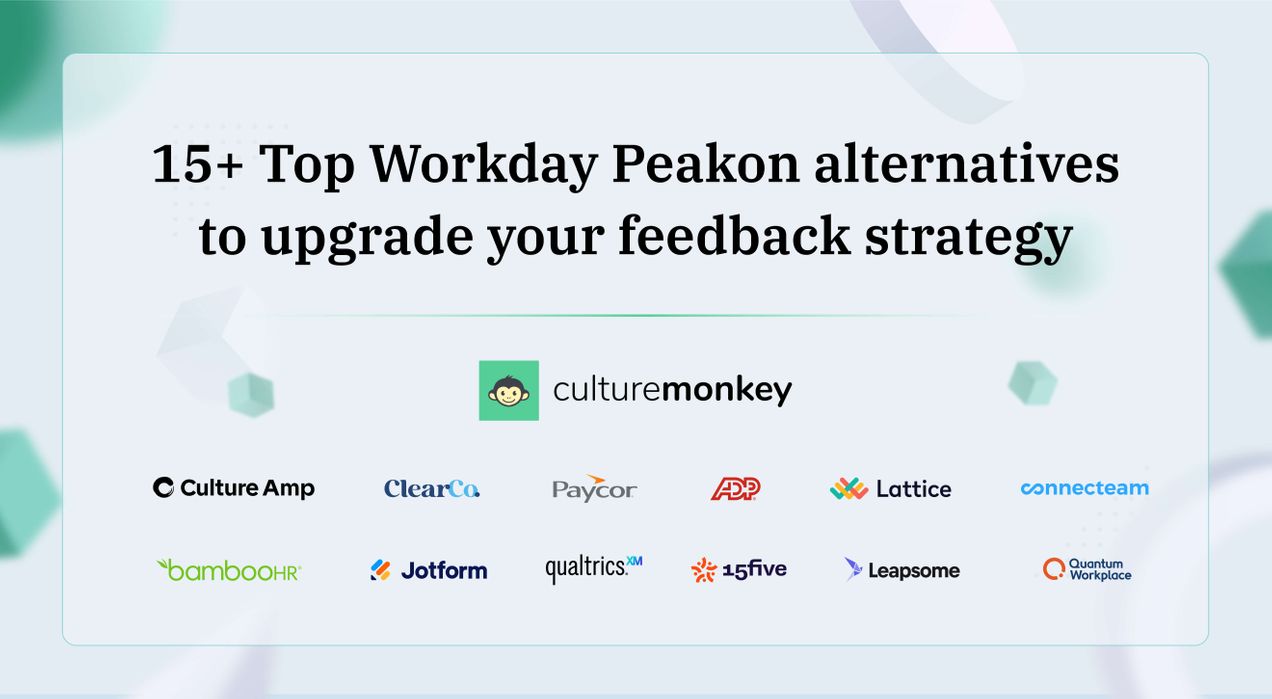Top 70+ employee net promoter score questions to measure employees' satisfaction

To measure employee loyalty is one of the biggest challenges management and HR professionals face throughout their careers. Perhaps in the past, people stayed with the same company for years or even their entire careers; but it's no longer the case.
When an employee leaves, replacing them isn't simple; a company must spend significant money and time searching for top talents through recruitment agencies, advertising, screening, interviewing, and hiring. According to Employee Benefits News, the average cost of losing an employee is 33% of their annual salary.
Previously, the salary was only crucial for employees to stick with a company; now, measuring employee engagement, flexibility, shared values, growth, recognition, and work-life balance have become some of the key factors to employee retention.
Thus, attracting and retaining employees is an integral part of any business, and it has evolved increasingly complexly over the past years.
Here's where the eNPS surveys come in and make employee retention less difficult. The eNPS is a metric that will be an indispensable part of the business toolkit by measuring and tracking employee loyalty.
Stay tuned; we’re just about to cover everything you need to know about employee net promoter scores and how to calculate them.
See how eNPS survey would look like in CultureMonkey's employee survey tool.
What is the employee net promoter score?
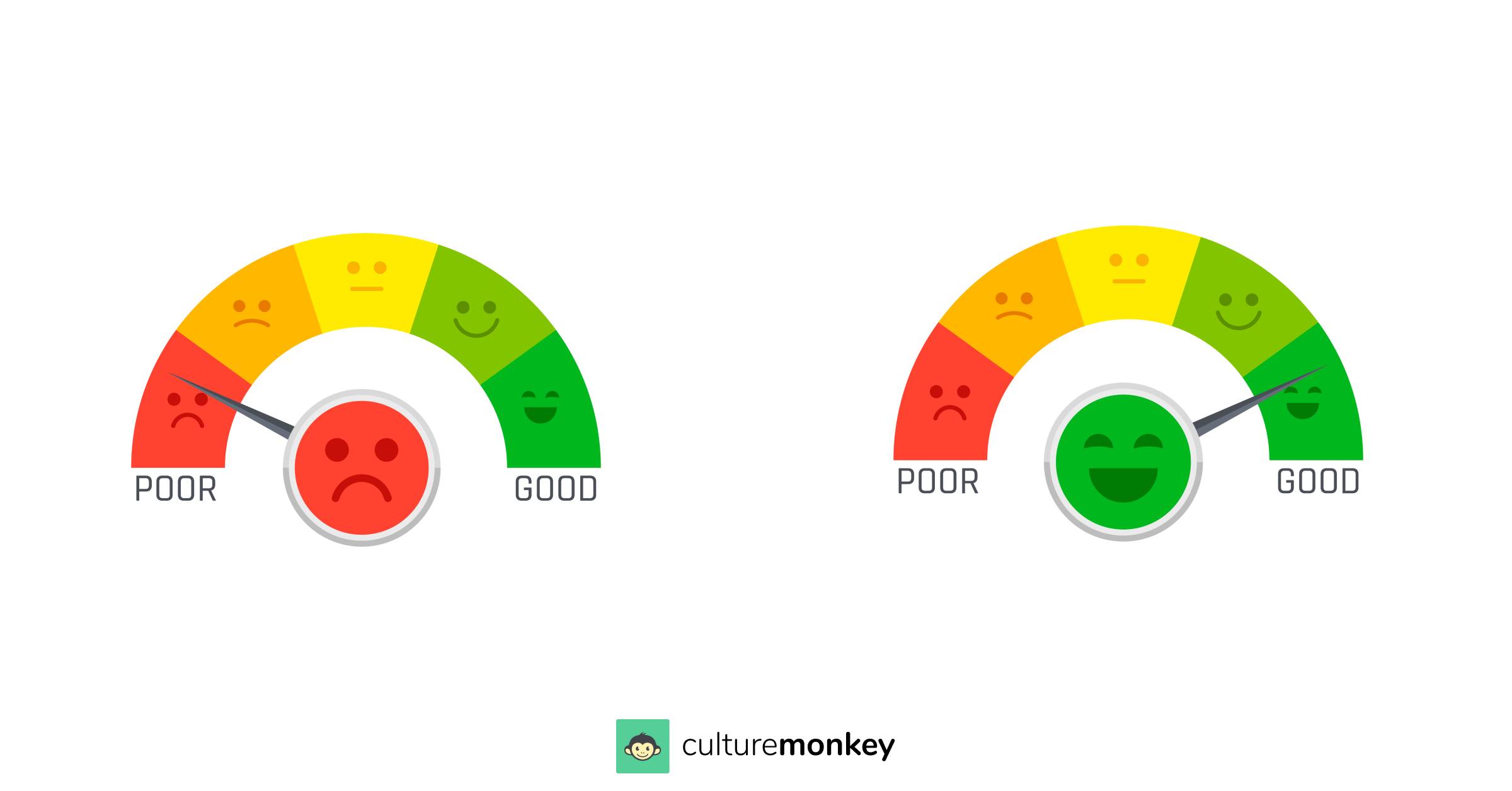
Employee net promoter score is a faster way to gauge employees' satisfaction in an organization and measure their loyalty to the company.
In layman's terms, it's nothing but how likely your employees are to recommend your organization for work amongst their friends and family. Thereby increasing your referrals and cutting down your hiring costs. Cool right?!
As an employer, when you nurture loyalty in employees, you will start seeing incredible benefits where employees will be more willing to invest in their work, pitch in new ideas, and go the extra mile. Forbes states that "Happy Employees = Hefty Profits."
You can control the problem of employees leaving the organization to a great extent but can't stop it completely. According to Willis Towers Watson, 53% of employees are either actively looking for a job or at risk of leaving.
But you can improve the employees' satisfaction by measuring eNPS since it will give you a fair understanding of how your engaged employees feel about working for your organization.
All the attributes combined make the eNPS more efficient when combined with other HR metrics to know what the employees feel negatively about your organization and improve their overall employee engagement by motivating them to be loyal.



You can’t expect your employees to exceed the expectations of your customers if you don’t exceed the employees’ expectations of management.
Chairman
Starbucks Coffee
Why is the eNPS important?

Measuring customer loyalty and satisfaction has been a company's primary measure of success and reputation for a long time. From the early '90s, organizations had a "Net Promoter Score" concept for measuring their services and products' popularity by asking simple questions like—How likely are you to recommend our services or products to your friends and family?
Similarly, to improve employee engagement and overall satisfaction is also important in the company culture.
Fred Reichheld from Bain & Company and Satmetrix introduced eNPS scores with similar NPS metrics to monitor and track how employees feel about their workplace.
According to Gallup, 51% of workers are not engaged as they are psychologically unattached to their company and work. They constantly seek employment opportunities and will leave for a slightly better offer.
So, to tackle all these hurdles, the eNPS provides you with deep insights into the recommendation to understand the engagement level for improving welfare and boosting employee productivity.
Workplace satisfaction motivates employees to be the best version of themselves and remain loyal to the organization. With this setup, employees would feel heard, less strained, and will have reduced workplace stress.
With the help of the eNPS score, you can divide the response into three simple categories.
- Promoters: These employees are more positive, satisfied, and motivated.
- Detractors: These employees are dissatisfied and will not recommend their workplace to others.
- Passives: These employees will be neutral and generally content but not generally satisfied or committed to the entire organization.
Tracking the share of promoters isn’t just a reporting exercise, it’s a predictor of overall engagement levels. Higher engagement translates into measurable gains: stronger loyalty, higher productivity, greater profitability, and better employee wellbeing.
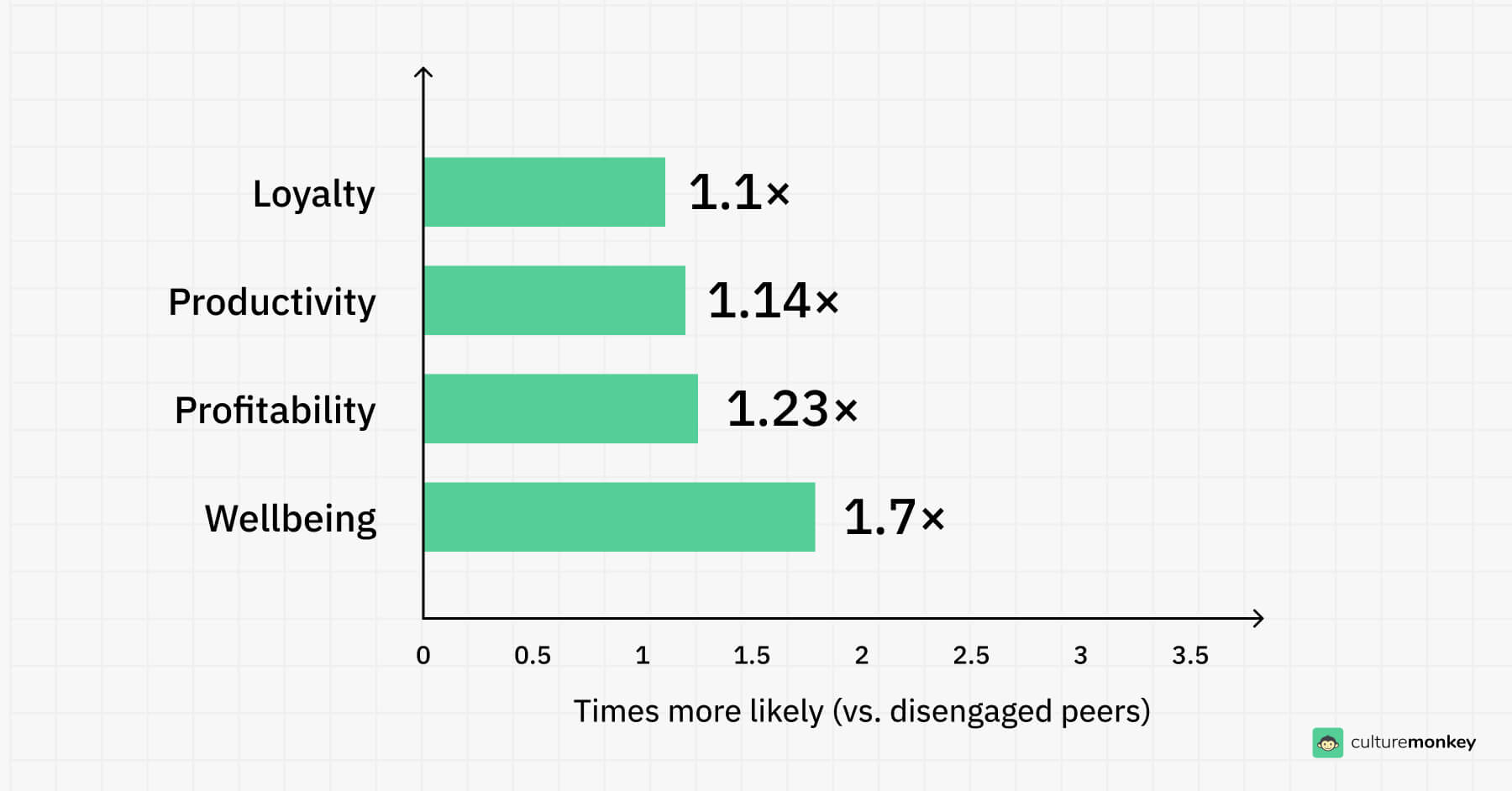
What's the difference between eNPS, employee loyalty surveys, and NPS?
| Aspect | eNPS | Employee Loyalty Surveys | NPS |
|---|---|---|---|
| Purpose and Focus | Measures employees' willingness to recommend their workplace to others, focusing on overall satisfaction and advocacy. | Evaluates employees' commitment and loyalty to the organization, examining factors such as job satisfaction and long-term retention. | Assesses customer loyalty by measuring how likely customers are to recommend a company’s product or service. |
| Scope and Depth | A single-question survey with follow-up inquiries for context, offering a high-level overview of employee satisfaction. | A comprehensive survey covering multiple topics, providing detailed insights into factors influencing employee loyalty and engagement. | A simple, direct survey asking one main question about recommendation, typically followed by an open-ended prompt. |
| Insights and Actionability | Provides a benchmarkable metric for quick identification of satisfaction trends and immediate areas of focus. | Delivers in-depth insights on specific drivers of loyalty, supporting long-term HR strategies and organizational improvements. | Offers actionable insights to gauge customer satisfaction and loyalty, enabling companies to improve their products/services. |
| Implementation Frequency | Can be conducted frequently (e.g., quarterly or monthly) due to its simplicity, enabling quick reactions to employee sentiment shifts. | Typically conducted annually or biannually, offering detailed insights that guide long-term employee engagement strategies. | Often conducted post-purchase or periodically to track customer sentiment and loyalty over time. |
What are the benefits of employee net promoter score?

Implementing and working through the eNPS score alongside other key metrics improves and creates a holistic view of the employee experience.
But in addition to satisfaction and engagement, employee net promoter score can help your business improve other metrics, like:
Usability
The most significant benefit of the eNPS is that it's easy to use. Employees only need to answer questions in a simple format (on a scale of 1–10), saving valuable time and eliminating survey fatigue.
Higher participation rates
Most of us are more familiar with survey fatigue; often, we might receive an email asking for 5 minutes of our time, and we think, "Okay, fine!" And after answering the first three questions, there will be another set of questions, which will take more than said time and frustrate us.
So, that's where survey fatigue happens. McKinsey defines survey fatigue as "a lack of motivation to participate in assessments." But with the employee net promoter score's simple method of answering, you can increase the employee participation rate in surveys and get accurate results.
Identifying general problem
The employee net promoter score is used to measure employee engagement, organizational problems, and satisfaction. These metrics help highlight underlying issues and optimize interdepartmental communication, employee recognition, and other workplace factors.
Accurate assessment with anonymity
The eNPS accurately reflects how your employees feel about recommending their workplace. Since every employee will answer the questions anonymously, they are more likely to be honest, which allows you to detect the causes of low productivity and employee engagement.
Employee attrition
Employee attrition is when the company gradually reduces employees over time, which means that employees might leave faster than recruitment.
Future Forum report titled—The great executive employee disconnect surveyed 10,569 knowledge workers in many countries, in which 63% of the U.S. workers are ready to seek a new job within the next year.
But by regularly measuring the employee net promoter score, the organization understands and prevents high employee attrition. Remember, employee retention and attrition are two sides of the same coin. So, results allow employers to gauge the issues before employees leave.
Continuous measuring
Tracking and monitoring problems in an organization can be hard for employers, so experts suggest that a company start with a score and consistently work to improve it.
According to Harvard Business Review, the eNPS inspires companies to have great customer satisfaction and success, which will also help bring back customers and improve business.
So when an organization deploys the employee net promoter score survey more frequently than annual employee surveys, it will pave the way for more effective monitoring.
Benchmarking suitability
Benchmarking provides critical insights to help employers understand how the organization has developed compared to past results. The eNPS is flexible and easy to benchmark and better understand when and where things may have changed or where the employer should focus more.
How can eNPS survey increase employee engagement?

It is crucial for all organizations since having effective workplace strategies helps create less employee turnover rate, better work culture, increase productivity, increase customer relationships, and positively impact profits.
But why does it matter for employees?
When employees are more engaged with their company, job, and colleagues, it helps their overall employee experience and workplace satisfaction. Employees become more optimistic, efficient, energized and surpass expectations, which naturally influences their mental health.
But according to Gallup, only 36% of U.S. employees are engaged in their workplace. So showing, as an employer, that you are listening and acting toward employees' feedback will help to increase engagement.
It will boost morale by displaying to employees that you care what they think and know their voice is heard, making them feel respected and included when they see the company take action to close employee experience gaps.



To win in the marketplace you must first win in the workplace.
CEO
Campbell’s Soup
Types of eNPS questions to include
Employee Net Promoter Score (eNPS) surveys are essential tools for gauging employee loyalty and satisfaction. To obtain comprehensive insights, it's crucial to incorporate a variety of question types beyond the standard "likelihood to recommend" query. Consider including the following:
- Open-ended questions: Encourage employees to elaborate on their experiences and provide specific feedback. For example, "What aspects of our workplace culture do you find most engaging?" This allows for a deeper understanding of employee sentiments.
- Likert scale questions: Assess the degree of agreement or disagreement with statements related to workplace factors. For instance, "On a scale of 1 to 5, how strongly do you agree that management communicates effectively?" This helps quantify perceptions of various aspects of the organization.
- Multiple-choice questions: Offer predefined options to identify common themes or issues. An example could be, "Which of the following benefits do you value most?" This aids in pinpointing areas for improvement or investment.
- Ranking questions: Ask employees to prioritize elements such as job satisfaction factors. For example, "Please rank the following in order of importance: compensation, work-life balance, career development, workplace environment." This provides insight into employee priorities.
- Demographic questions: Collect information on employee demographics to analyze trends across different groups. Questions like "Which department do you work in?" or "How long have you been with the company?" enable targeted analysis and interventions.
How to use employee net promoter score effectively?

So what's next after successfully implementing the employee net promoter score survey?
Remember the golden rule—there is always room for improvement. So ensure you leverage the employee net promoter score to get better.
Right solution
According to People Doc, nearly 50% of employees are less truthful in their answers. Ensure the results are always anonymous; by doing so, you allow your employees to be more honest. To implement the right solution, you can filter survey findings to reveal differences based on location, department, and demographic.
Extensive programs for employee satisfaction
Measuring and calculating eNPS would provide more depth of understanding on employees' satisfaction and engagement to help employers understand why specific employees are detractors vs promoters and take possible actions to satisfy employees' needs.
Happy customers, happy employees!
Companies have to measure customer NPS surveys during employee net promoter scores because these two metrics are often aligned. If your employees are happy and more engaged at the workplace, they will be willing to go that extra mile to put a smile on your customers' faces.
Normalize listening
You have to normalize the process of you listening and taking care of your employees. So you must make sure that you conduct employee net promoter score surveys at regular intervals (pulse surveys) to get enough data about your employees and find the current trend.
But, when you implement surveys too far apart, you won't be able to pinpoint the challenges or get enough data to be on trend with your employees.
Be transparent
Glassdoor defines workplace transparency as "an organization that operates in a way that creates openness between managers and employees." So don't hide your eNPS from your employees; make them feel more invested and included rather than removing them from the evaluation process.
Take action
Once you pinpoint the employee engagement challenges and experience gaps your employees face, ensure you dedicate resources to implement an immediate change.
When it comes to workplace engagement, the worst thing you can do is ask for employee feedback and fail to take action, and it develops distrust among employees, who are more likely not to participate in future surveys.
According to SHRM, one in three employees doesn't trust and report their problems to the employer or HR since they don't fix the issue. So, be sure you show that you are more committed to improving employee engagement.
Benchmarking
Compare your eNPS with industry standards to understand where your organization stands. This benchmarking can highlight areas needing urgent attention and provide insights into best practices followed by top-performing companies.
Continuous improvement
Use eNPS data as part of a continuous improvement strategy. Regularly review and adjust your strategies based on the feedback received, ensuring that you are consistently meeting the evolving needs and expectations of your employees.
How do you measure employee engagement through eNPS?

The employee net promoter score is the actual difference between your engaged and disengaged employees. The best way to measure it is to use recurrent survey questions more frequently to identify the improvement in employee engagement activities.
Here, the employees will answer the question on a scale of 0–10, with 0 being the least likely to recommend their workplace and 10 being more likely to recommend.
eNPS formula:
eNPS = No. of Promoters – No. of Detractors/Total No. of Respondents x 100
- Promoters are those who gave a score of either 9 or 10
- Detractors are those who gave a score between 0–6
- Passives are those who gave a score of either 7 or 8
Calculation examples
Let's take an example—company A wants to identify their employees' loyalty and satisfaction, and they have a total of 2000 employees and received 2000 responses. Where
- 200 responses were from detractors (0–6 range)
- 600 responses were from passives (7–8 range)
- 1200 responses were from promoters (9–10 range)
Using the eNPS formula: 1200-200/2000x100 = 50
A result is always a whole number and not a percentage; hence, company A's employee net promoter score is 50.
From the above calculation, it's evident that company A needs to analyze the root cause behind a low employee net promoter score and work to improve employee satisfaction.
Satisfied employees lead to satisfied customers
Satisfied employees can have a significant impact on the satisfaction of customers. A happy, engaged employee is more likely to be productive, be more productive, and remain loyal to their employer, which creates a positive customer experience.
Creating a culture of employee satisfaction requires companies to focus on factors such as communication, recognition, and development opportunities. Listening to feedback through employee engagement surveys, such as the eNPS, can help identify pain points and areas for improvement.
By focusing on employee satisfaction, companies can create a positive cycle where happy employees lead to satisfied customers, which leads to increased business success.
Identifying promoters, passives & detractors

The eNPS questions can be used to identify promoters, passives, and detractors and take action to improve employee engagement and satisfaction levels. Here are the reasons why companies should identify promoters, passives, and detractors:
Promoters
Promoters are employees who give a score of 9 or 10 on the eNPS survey, indicating a high likelihood of recommending the company as a great place to work. Promoters are likely to have a positive experience with the company culture, leadership, and work environment.
They may feel valued and recognized for their contributions and may have opportunities for growth and development within the company. Companies can leverage promoters by identifying and celebrating their successes and providing mentorship and leadership development opportunities.
Passives
Passives are employees who score 7 or 8 on the eNPS survey, indicating a neutral or mixed opinion about the company as a workplace.
Passives may have had positive experiences with some aspects of the company, but may also have concerns or frustrations that prevent them from being fully engaged and satisfied.
Companies can use eNPS feedback from passives to identify areas for improvement and take action to address their concerns. For example, improving communication or offering more opportunities for collaboration and teamwork can help increase employee engagement and satisfaction.
Detractors
Detractors are employees who score 0-6 on the eNPS survey, indicating a low likelihood of recommending the company as a place to work. Detractors may have had negative experiences with the company culture, leadership, or work environment. They may feel undervalued, unsupported, or disengaged and may be at risk of leaving the company.
Companies must address detractors' concerns to prevent turnover and maintain a positive workplace culture. By listening to detractors' feedback and taking action to address their concerns, companies can improve employee engagement and satisfaction, leading to better overall performance.
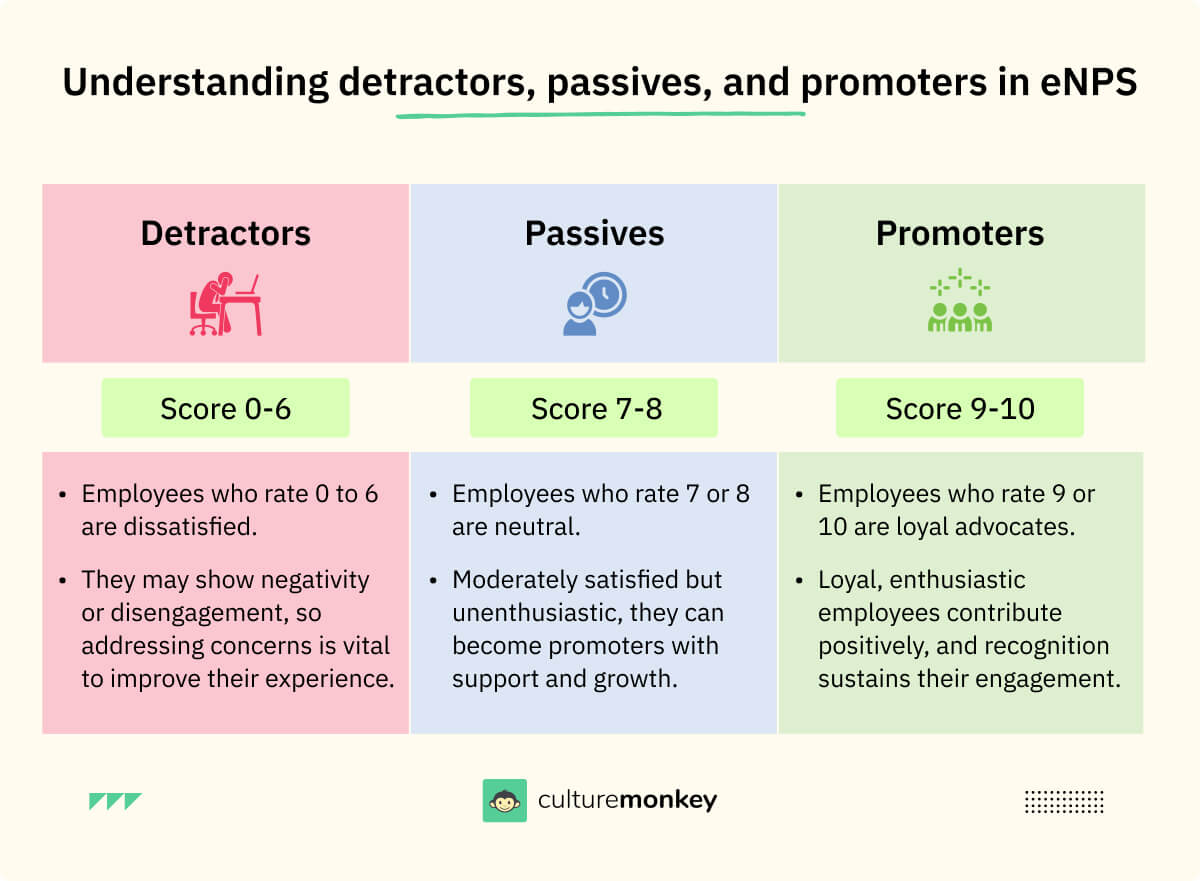
Why eNPS questions guides strategy?
By asking employees how likely they are to recommend the company as a great place to work, eNPS provides a simple and effective way to gauge overall employee sentiment. But eNPS is not just a metric, it's a strategic tool that can guide a company's approach to creating a positive workplace culture.
The eNPS survey provides valuable feedback from employees that can be used to guide strategy in several ways. For example, feedback from detractors can highlight specific areas where improvements are needed, such as better communication, more opportunities for growth and development, or a better work-life balance.
In addition to addressing specific issues highlighted by detractors, eNPS feedback from promoters can also guide strategy by highlighting areas where the company is doing well. This can help companies identify their strengths, build on them, and better understand what motivates employees and drives engagement.
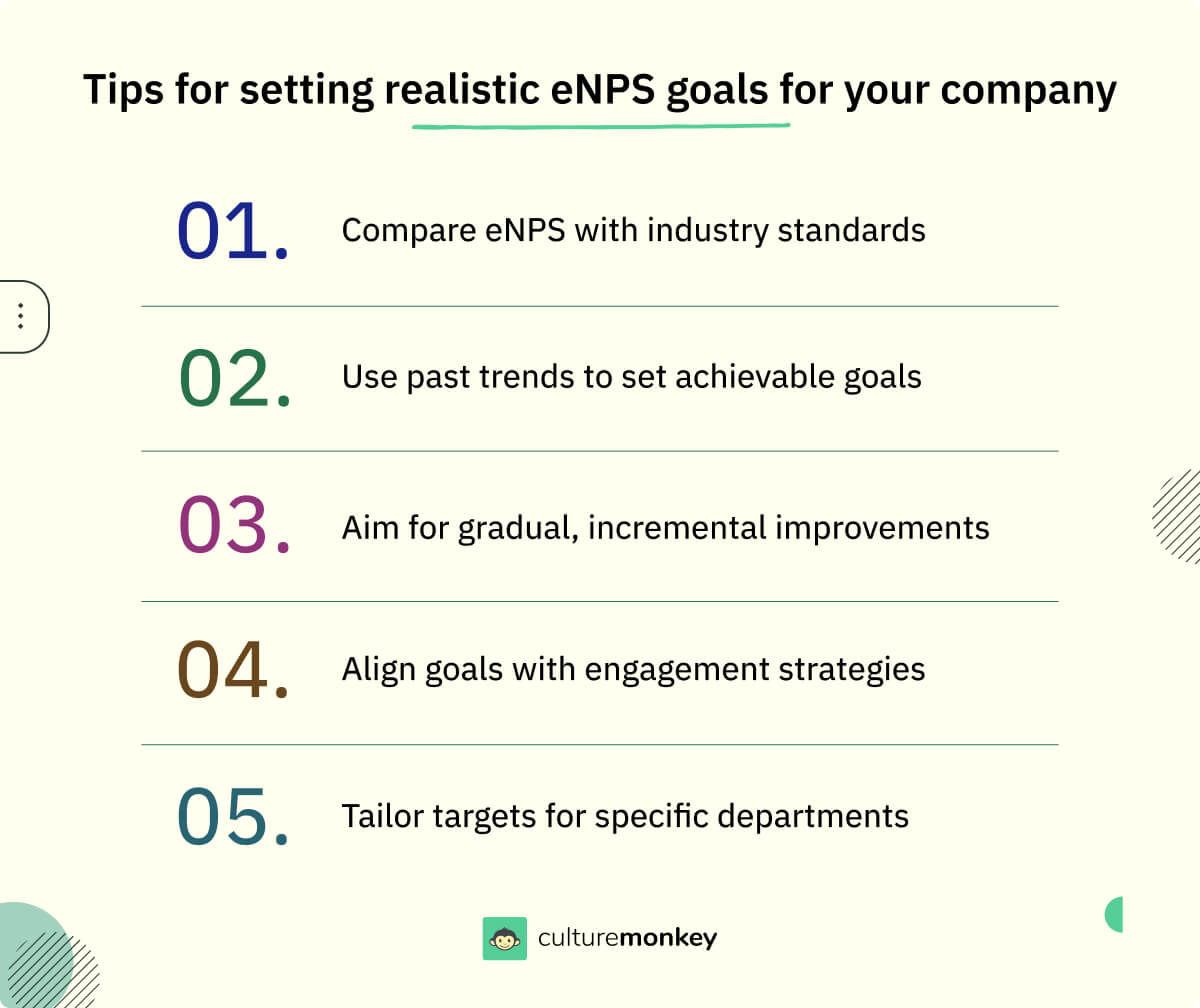
eNPS and other employee metrics
When it comes to measuring employee engagement and satisfaction, companies can use many different metrics. Each metric provides unique insights into employee sentiment, and no single metric can provide a complete picture of workforce engagement.
However, the eNPS metric has gained popularity recently and is often preferred by companies over other employee metrics.
The eNPS metric focuses specifically on employee loyalty and their likelihood to recommend the company as a place to work.
It is a simple and easy-to-understand metric with a scoring system that ranges from -100 to 100. This makes it easy for companies to track their eNPS scores over time and compare them to industry benchmarks.
That being said, it's important to note that eNPS is not a replacement for other employee metrics.
Rather, it should be used in conjunction with other metrics through employee engagement surveys, like pulse surveys, employee satisfaction surveys, diversity & inclusion surveys, and manager effectiveness surveys, to gain a more complete picture of employee sentiment.
Common challenges and pitfalls to avoid when implementing eNPS surveys

Implementing eNPS surveys can be instrumental in understanding employee sentiment and driving organizational improvement initiatives. However, there are several common challenges and pitfalls that organizations should be mindful of to ensure the effectiveness of these surveys. Here are key points to consider:
- Survey fatigue: One of the primary challenges is survey fatigue, where employees may become inundated with various surveys, leading to decreased participation and lower quality responses. To mitigate this, organizations should streamline survey frequency, ensuring that eNPS surveys are conducted at intervals that balance the need for feedback with employees' time constraints.
- Lack of actionable insights: Merely collecting eNPS survey data without a clear plan for action can render the exercise futile. It's essential to have mechanisms in place for analyzing survey results, identifying trends, and translating feedback into actionable insights. Without this, employees may perceive eNPS surveys as mere lip service, eroding trust and engagement.
- Inadequate communication: Failure to communicate the purpose, significance, and outcomes of eNPS surveys to employees can result in skepticism and apathy. Clear communication regarding the goals of the survey, how feedback will be utilized, and the importance of employee participation is crucial for fostering trust and engagement.
- Limited feedback channels: Relying solely on eNPS surveys for employee feedback may overlook nuanced issues and sentiments that require more qualitative approaches. Organizations should complement eNPS surveys with other feedback mechanisms such as focus groups, one-on-one interviews, or suggestion boxes to capture a holistic view of employee experiences.
- Bias and response rate issues: Biases in survey responses, such as social desirability bias or acquiescence bias, can skew eNPS results and undermine their validity. Moreover, low response rates may lead to sample bias, where the feedback does not accurately represent the diverse perspectives within the organization. Employing techniques such as anonymizing responses and incentivizing participation can help mitigate these challenges.
- Lack of leadership buy-in: Without leadership buy-in and commitment to act on eNPS feedback, implementation efforts are likely to falter. Leaders should champion the importance of employee feedback, actively participate in survey initiatives, and demonstrate a willingness to address identified areas for improvement.
- Overemphasis on scores: Focusing solely on eNPS scores as a measure of success may overshadow the qualitative insights gleaned from employee feedback. While scores provide a quantitative benchmark, organizations should prioritize understanding the underlying drivers behind the scores to drive meaningful change.
How to improve your employee net promoter scores?

Taking the proper steps to understand and measure eNPS has significant value, and it helps decision-makers address employees' concerns and foster more promoters. Here are some tips to help you improve your employee NPS and customer NPS survey.
- Collaborate with senior leaders, as teamwork always starts at the top, and everyone should be more committed to continuous improvement. Ensure you are ready to invest in your training, culture, and recruitment, which will lead you a long way.
- Assure your employees that their honest feedback is completely anonymous and safe to provide. Working with a third-party company to implement an employee net promoter score helps since failure to provide anonymity leads to employees not providing the right or accurate information.
- Track your reputation on all available platforms since employees or former employees often write reviews on sites like Indeed, Glassdoor, LinkedIn, Comparably, Vault, and Careerbliss. The reviews might be an eye-opener for you!
- Cultivate an environment where your employees provide input and are comfortable sharing feedback, like anonymous employee opinion surveys, and make sure you are transparent about the results.
- Acknowledge and celebrate your employees for going above and beyond in simple methods, such as responding to their feedback and taking appropriate actions, which are some best ways to cultivate workplace satisfaction.
70+ Best eNPS survey questions you need to ask in 2025

The employee net promoter score survey opens the door for constructive and honest communication between employees and employers.
You can take further steps to increase employee satisfaction to raise the score. The following are some crucial employee net promoter score survey questions:
- Is there any specific factor that prevents you from recommending your workplace to others? [scale of 0–10]
- Has your experience at the company improved over the past 6 months? [scale of 0–10]
- Would you say your company invests enough resources in employee engagement and satisfaction? [scale of 0–10]
- How helpful is your manager when you come across an issue at work? [scale of 0–10]
- Do you see yourself working here in the next 5 years? [scale of 0–10]
- How valued and recognized do you feel in your workplace? [scale of 0–10]
- How interesting or exciting would you say your work is? [scale of 0–10]
- Did any recent changes in the workplace improve, impair, or have no impact on your work experience? [scale of 0–10]
- Would you say your workplace is more attractive to the employees than its competitors? [scale of 0–10]
- How closely would you say our organization met your expectations? [scale of 0–10]
- How likely are you to recommend our company to your friends and family? [scale of 0–10]
- Do you enjoy working here at our company? [scale of 0–10]
- Do you think that we are prioritizing workplace culture and work-life balance? [scale of 0–10]
- How strongly are you willing to go the extra mile for the company? [scale of 0–10]
- What do you like the least about our organization? [Open-ended question]
- How satisfied are you with the communication channels within the organization? [scale of 0–10]
- Are you satisfied with the opportunities for career growth and development provided by the company? [scale of 0–10]
- How effective do you find the performance feedback and evaluation process at our company? [scale of 0–10]
- Do you feel that your workload is manageable and reasonable? [scale of 0–10]
- How satisfied are you with the level of diversity and inclusion in our workplace? [scale of 0–10]
- Are you satisfied with the benefits and perks offered by the company? [scale of 0–10]
- How well do you feel your skills and talents are utilized in your current role? [scale of 0–10]
- Do you feel empowered to voice your opinions and ideas within the organization? [scale of 0–10]
- How satisfied are you with the level of collaboration and teamwork within your department? [scale of 0–10]
- Are you satisfied with the level of transparency regarding company goals and decisions? [scale of 0–10]
- How well do you feel the company recognizes and rewards employee contributions? [scale of 0–10]
- Do you feel that your work-life balance is respected by your supervisors and colleagues? [scale of 0–10]
- How satisfied are you with the overall work environment and office facilities? [scale of 0–10]
- Are you satisfied with the training and development opportunities provided by the company? [scale of 0–10]
- How well do you feel the company supports employee well-being and mental health? [scale of 0–10]
- How satisfied are you with the company's efforts in fostering a sense of belonging and inclusion among employees from diverse backgrounds? [scale of 0–10]
- How effective do you find the company’s conflict resolution process? [scale of 0–10]
- Do you feel that the company’s values align with your personal values? [scale of 0–10]
- How likely are you to recommend our products/services to others? [scale of 0–10]
- How satisfied are you with the company’s efforts to maintain a safe work environment? [scale of 0–10]
- Do you feel that your career goals align with the company’s goals? [scale of 0–10]
- How well does the company support professional development through external courses or certifications? [scale of 0–10]
- Are you satisfied with the flexibility of your work schedule? [scale of 0–10]
- How well does the company handle feedback from employees? [scale of 0–10]
- Do you feel that you have a clear understanding of your career path at the company? [scale of 0–10]
- How satisfied are you with the company’s approach to technological innovation and tools? [scale of 0–10]
- Do you feel that the company’s leadership is approachable and responsive? [scale of 0–10]
- How well does the company facilitate a healthy balance between personal and professional life? [scale of 0–10]
- Are you satisfied with the company’s commitment to corporate social responsibility? [scale of 0–10]
- How effective do you find the company’s internal communication tools and platforms? [scale of 0–10]
- Do you feel that the company provides adequate opportunities for networking and mentorship? [scale of 0–10]
- How satisfied are you with the recognition programs in place for team achievements? [scale of 0–10]
- Do you feel that the company adequately supports a culture of continuous improvement? [scale of 0–10]
- Are you satisfied with the transparency of the company’s financial health and stability? [scale of 0–10]
- How well does the company support remote working conditions? [scale of 0–10]
- Do you feel that the company encourages and values innovation from all levels? [scale of 0–10]
- How satisfied are you with the company’s support for your personal development? [scale of 0–10]
- Do you feel that the company promotes a healthy work environment? [scale of 0–10]
- How effective is the leadership team in communicating the company’s vision? [scale of 0–10]
- Do you believe your role contributes meaningfully to the company’s success? [scale of 0–10]
- How well does the company support flexible work arrangements? [scale of 0–10]
- Are you satisfied with the level of autonomy you have in your role? [scale of 0–10]
- How likely are you to stay with the company for the next two years? [scale of 0–10]
- Do you feel that there are adequate opportunities for career progression? [scale of 0–10]
- How satisfied are you with the level of feedback you receive from leadership? [scale of 0–10]
- Do you feel that your work is appreciated by your peers? [scale of 0–10]
- How well do the company’s values reflect in its day-to-day operations? [scale of 0–10]
- How likely are you to recommend your team as a great place to work? [scale of 0–10]
- How well does the company recognize the achievements of individual employees? [scale of 0–10]
- Are you satisfied with the company’s focus on innovation and staying competitive? [scale of 0–10]
- Do you feel that the company supports your long-term career goals? [scale of 0–10]
- How satisfied are you with the company’s communication of major changes? [scale of 0–10]
- How effectively does the company handle employee concerns? [scale of 0–10]
- Do you feel that the company creates a sense of community? [scale of 0–10]
- How satisfied are you with the opportunities to contribute to meaningful projects? [scale of 0–10]
- Do you feel empowered to take ownership of your work? [scale of 0–10]
What is a good eNPS?

Determining what constitutes a good Employee Net Promoter Score (eNPS) requires a nuanced understanding of the factors contributing to employee satisfaction and loyalty. Here are the key characteristics that signify a strong eNPS:
- High overall score: A good eNPS typically reflects a high percentage of promoters (those rating 9-10) compared to detractors (those rating 0-6) in the employee survey responses. This indicates that a significant majority of employees are highly satisfied and likely to recommend their workplace to others.
- Consistency over time: Consistency in eNPS scores across multiple survey periods suggests stable levels of employee satisfaction and engagement. Fluctuations in scores may indicate underlying issues that require attention or external factors influencing employee morale.
- Positive trends: A consistently increasing eNPS trend over time signifies ongoing improvements in employee satisfaction and loyalty. Positive trends indicate that the organization's efforts to enhance the employee experience are yielding results and resonating with employees.
- Alignment with organizational goals: A good eNPS is aligned with the organization's broader goals and values. When employees' perceptions of the company's culture, leadership, and opportunities for growth mirror the organization's stated objectives, it fosters a sense of alignment and purpose among employees.
- Open communication channels: A strong eNPS often accompanies a culture of open communication where employees feel empowered to share feedback and concerns. Organizations with high eNPS scores frequently have robust feedback mechanisms in place, such as regular surveys, anonymous suggestion boxes, or avenues for one-on-one discussions with management.
- Investment in employee development: Companies that prioritize employee development and provide ample opportunities for learning and growth tend to have higher eNPS scores. Investing in training programs, mentorship initiatives, and career advancement opportunities demonstrates a commitment to employees' professional development and contributes to their overall satisfaction.
- Recognition and rewards: Acknowledging and rewarding employees for their contributions plays a crucial role in fostering a positive work environment and boosting eNPS. Recognition programs that celebrate achievements, milestones, and exemplary performance reinforce a culture of appreciation and motivate employees to go above and beyond.
- Strong leadership and supportive management: Leadership effectiveness is closely linked to eNPS, as employees often look to their leaders for guidance, support, and inspiration. A good eNPS is indicative of strong leadership that communicates clearly, leads by example, and actively engages with employees to address their needs and concerns.
Employee Net Promoter Score survey structure
- Set clear objectives: Before designing the survey, define what you aim to achieve. Are you measuring overall employee sentiment, loyalty, or workplace satisfaction? Clear goals will guide your survey content and action plans.
- Design the core question: The core eNPS question is: "On a scale of 0–10, how likely are you to recommend our company as a great place to work?" This question offers a straightforward metric for employee satisfaction and advocacy, setting the foundation for the survey.
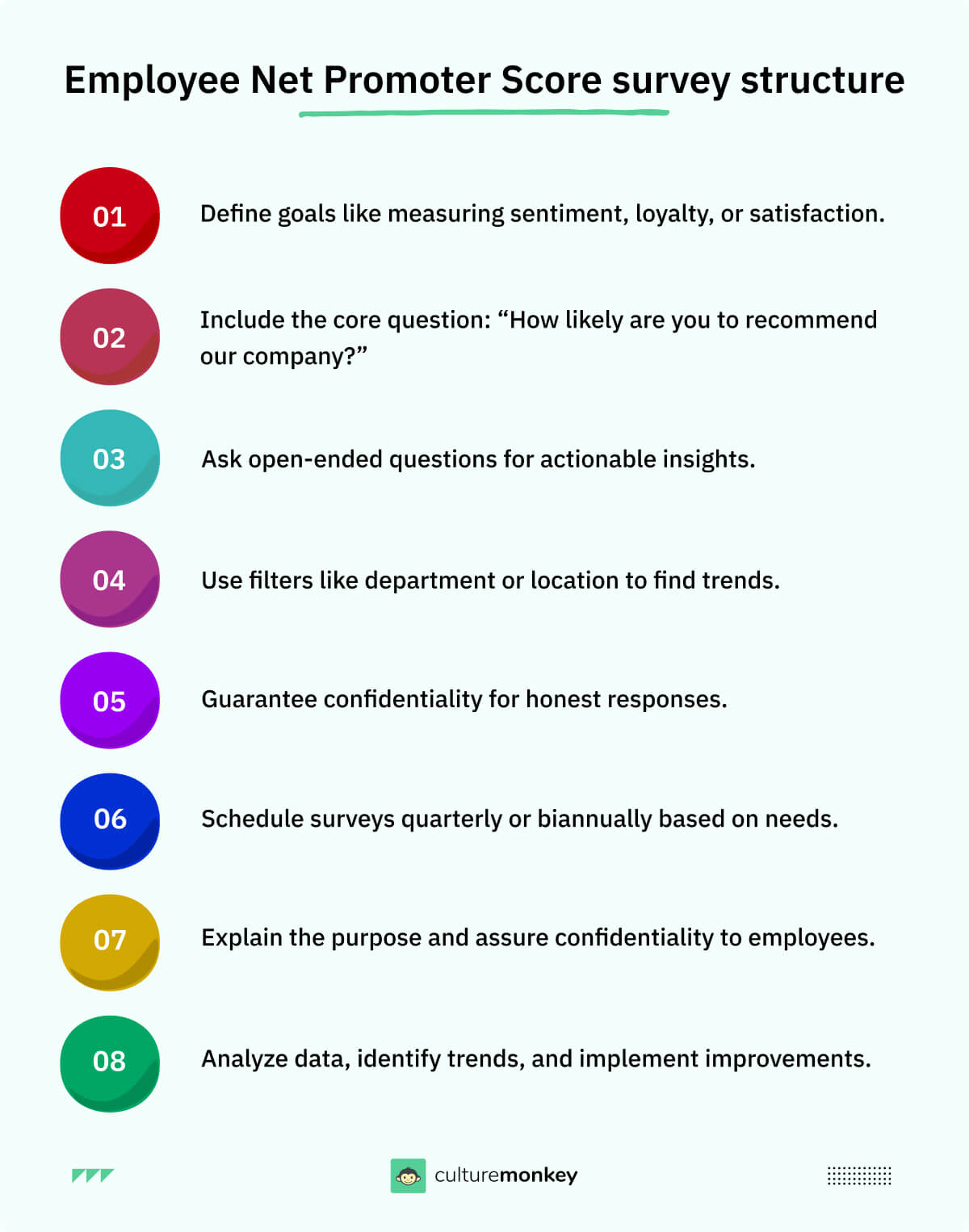
- Add follow-up questions: To gather deeper insights, include follow-up questions like, “What factors influenced your score?” or “What could we improve?” Open-ended questions encourage employees to explain their ratings, providing actionable feedback.
- Include demographic filters: Add demographic questions to analyze responses across different groups, such as departments, locations, or tenure. This helps in identifying trends and addressing specific areas needing attention.
- Ensure anonymity: Guaranteeing anonymity encourages honest feedback. Employees are more likely to provide candid responses when they know their identities won’t be revealed.
- Choose the right timing: Decide how frequently to conduct the survey, whether quarterly or biannually. Timing depends on your organization’s needs and capacity to act on the feedback.
- Communicate clearly: Inform employees about the purpose of the survey, how the data will be used, and reassure them about confidentiality. Clear communication builds trust and increases participation rates.
- Analyze and act on results: After collecting responses, segment the data and identify key trends. Use this feedback to implement improvements and communicate back to employees about the actions taken.
Actionable steps after gathering eNPS data
Once you've collected Employee Net Promoter Score (eNPS) data, the next phase involves transforming these insights into meaningful actions. Below are actionable steps to follow:
- Analyze and segment the data: Break down the eNPS data by relevant demographics, such as department, location, or tenure. This segmentation helps identify patterns and understand which areas of the organization need attention. For instance, lower scores in certain teams may highlight management issues, while higher scores in other areas can point to best practices worth replicating.
- Identify key trends and common themes: Examine qualitative feedback from follow-up questions to pinpoint recurring themes, both positive and negative. Whether it's feedback about leadership, work-life balance, or professional development, understanding these common threads helps focus improvement efforts in the right direction.
- Communicate the results with transparency: Share the eNPS results with employees in a clear and transparent way. Communicating both the strengths and areas for improvement fosters trust and shows employees that their voices are being heard. Be sure to emphasize that their feedback is driving change.
- Prioritize quick wins: Identify actionable items that can be implemented quickly. These “quick wins” help demonstrate that feedback is being taken seriously. For example, if employees express concerns about communication, simple measures like improving internal communication tools or processes can be implemented promptly.
- Create long-term strategic plans: For deeper-rooted issues, develop longer-term action plans. Issues such as career development or workplace culture improvements might require more time and effort. Establish specific goals and timelines to address these larger concerns, and ensure leadership is involved in the process.
- Involve employees in the solution: Invite employees to contribute to brainstorming solutions. Employee involvement not only fosters engagement but also ensures that the actions taken will address their concerns more effectively.
- Monitor progress and adjust as needed: After implementing changes, regularly monitor the impact and continue gathering feedback. eNPS surveys should be part of an ongoing effort to improve employee satisfaction.
The Role of Technology in eNPS Surveys
Technology plays a critical role in enhancing the effectiveness of eNPS surveys, providing tools that streamline the process and ensure valuable insights are gained. Below are key ways employee engagement survey tools contribute to eNPS surveys:
- Automated survey distribution: Survey tools automate the entire distribution process, making it easy to send eNPS surveys to employees across different departments, locations, and even time zones. This saves time and ensures consistent survey intervals.
- Real-time data collection: Engagement tools enable real-time data collection, allowing organizations to receive immediate feedback from employees. This helps HR teams and leadership stay updated on employee sentiment without delays.
- Advanced analytics and reporting: Technology allows for powerful data analytics, generating detailed reports on eNPS scores. Employee engagement survey tools can segment data by various filters, such as job roles, locations, or tenure, enabling deeper insights and more informed decision-making.
- Mobile-friendly surveys: Employee engagement survey tools are often mobile-friendly, allowing employees to easily participate in surveys from their smartphones or tablets. This increases accessibility and participation rates, particularly for remote workers or employees on the go.
- Anonymity and confidentiality: Technology ensures survey anonymity, which is crucial for gathering honest feedback. Tools can anonymize responses, giving employees the confidence to provide candid insights without fear of repercussions.
- Customizable follow-up questions: Survey tools enable the customization of follow-up questions based on the initial eNPS score. This allows organizations to dive deeper into specific issues and gain a better understanding of what drives employee satisfaction or dissatisfaction.
- Benchmarking and industry comparisons: Many survey platforms offer benchmarking features that allow companies to compare their eNPS scores against industry standards. This provides valuable context and helps companies set realistic goals for improving employee engagement.
- Integration with HR systems: Employee survey vendors often integrate seamlessly with HR management systems, enabling organizations to automatically sync employee data for better analysis. This integration also helps streamline survey administration and follow-up processes.
- Actionable insights and recommendations: Advanced survey platforms can offer actionable insights and recommendations based on the eNPS results. These tools use data-driven analysis to suggest specific actions HR teams can take to address problem areas or enhance positive aspects of employee engagement.
- Continuous feedback loops: Technology supports continuous feedback loops by enabling companies to run frequent eNPS surveys. This ongoing feedback helps organizations track changes in employee sentiment over time and ensure that improvements are sustained.
Benefits of an eNPS survey with CultureMonkey
Implementing an eNPS survey through an employee engagement platform like CultureMonkey provides numerous advantages for organizations aiming to enhance workplace satisfaction and loyalty.
- Custom eNPS surveys for efficiency: Create tailored surveys with targeted questions to uncover satisfaction drivers. Choose your audience, schedule for future, and automate recurring surveys for continuous insights.
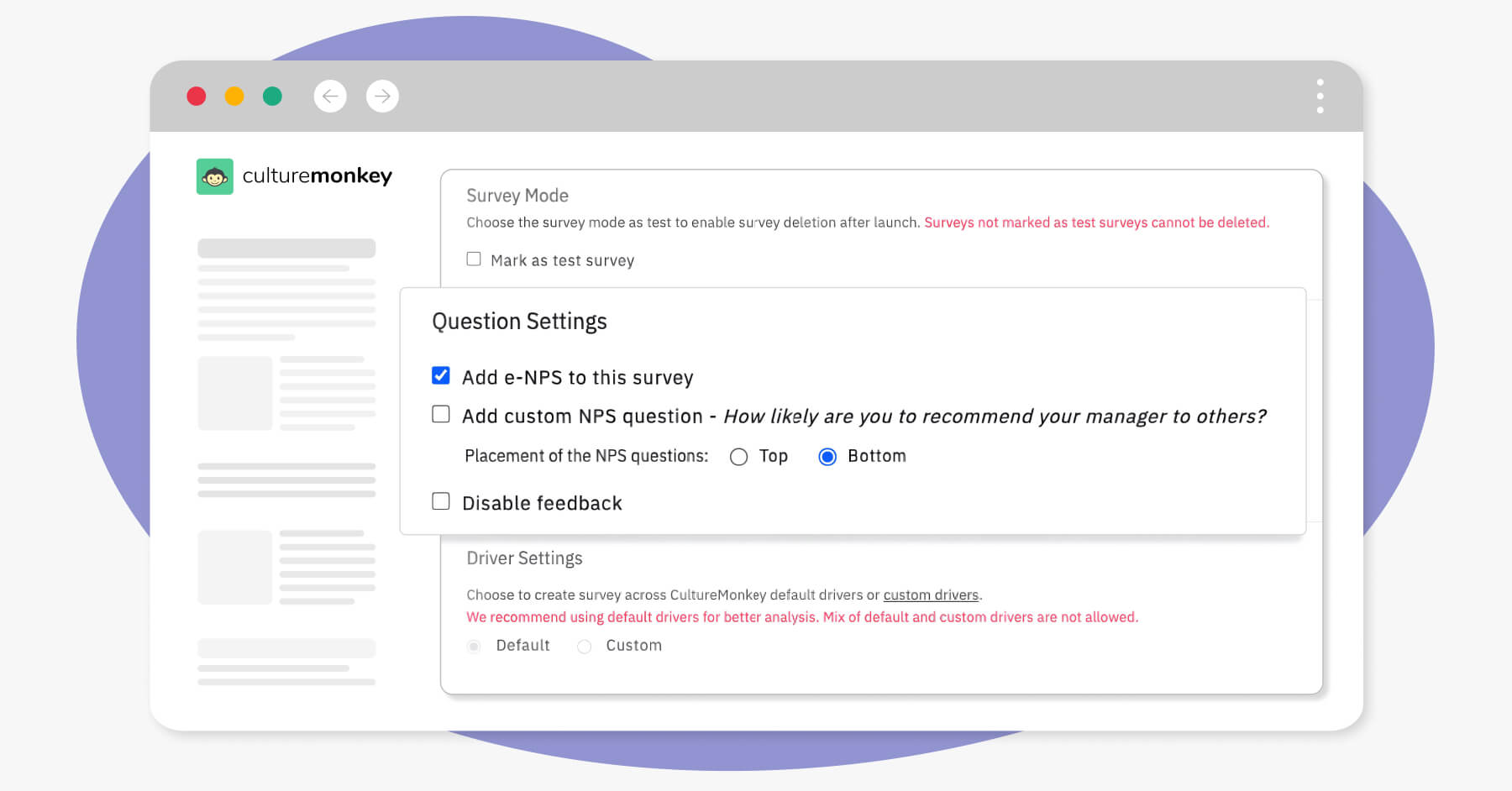
- Unveil employee feedback anonymously: Gain honest feedback with anonymous surveys. Use open-ended questions to identify detractors, address concerns, and boost workplace satisfaction.
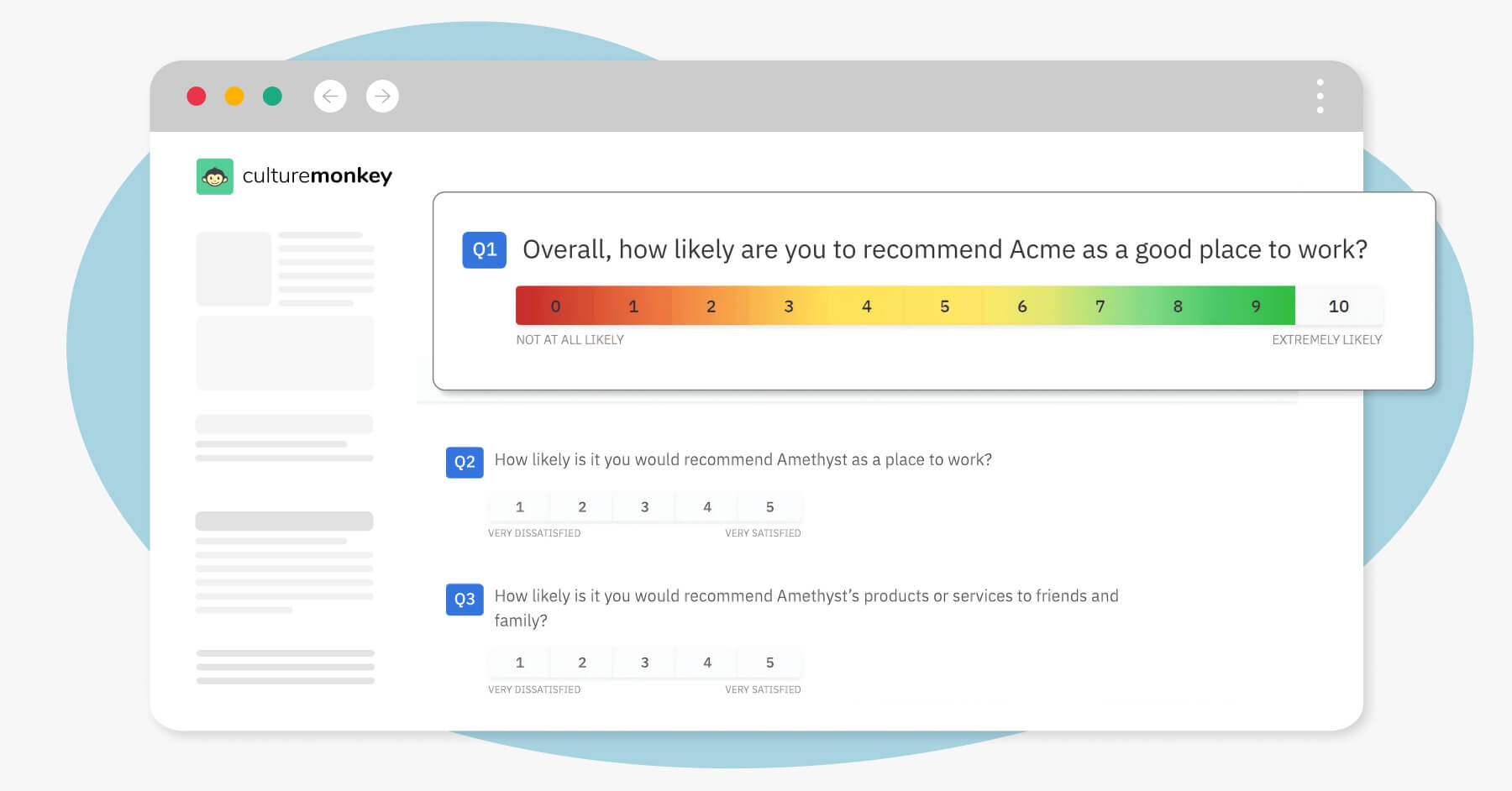
- Use preferred communication channels: Engage employees on platforms like WhatsApp, Slack, email, or SMS. Include QR codes or kiosks for convenient feedback collection.
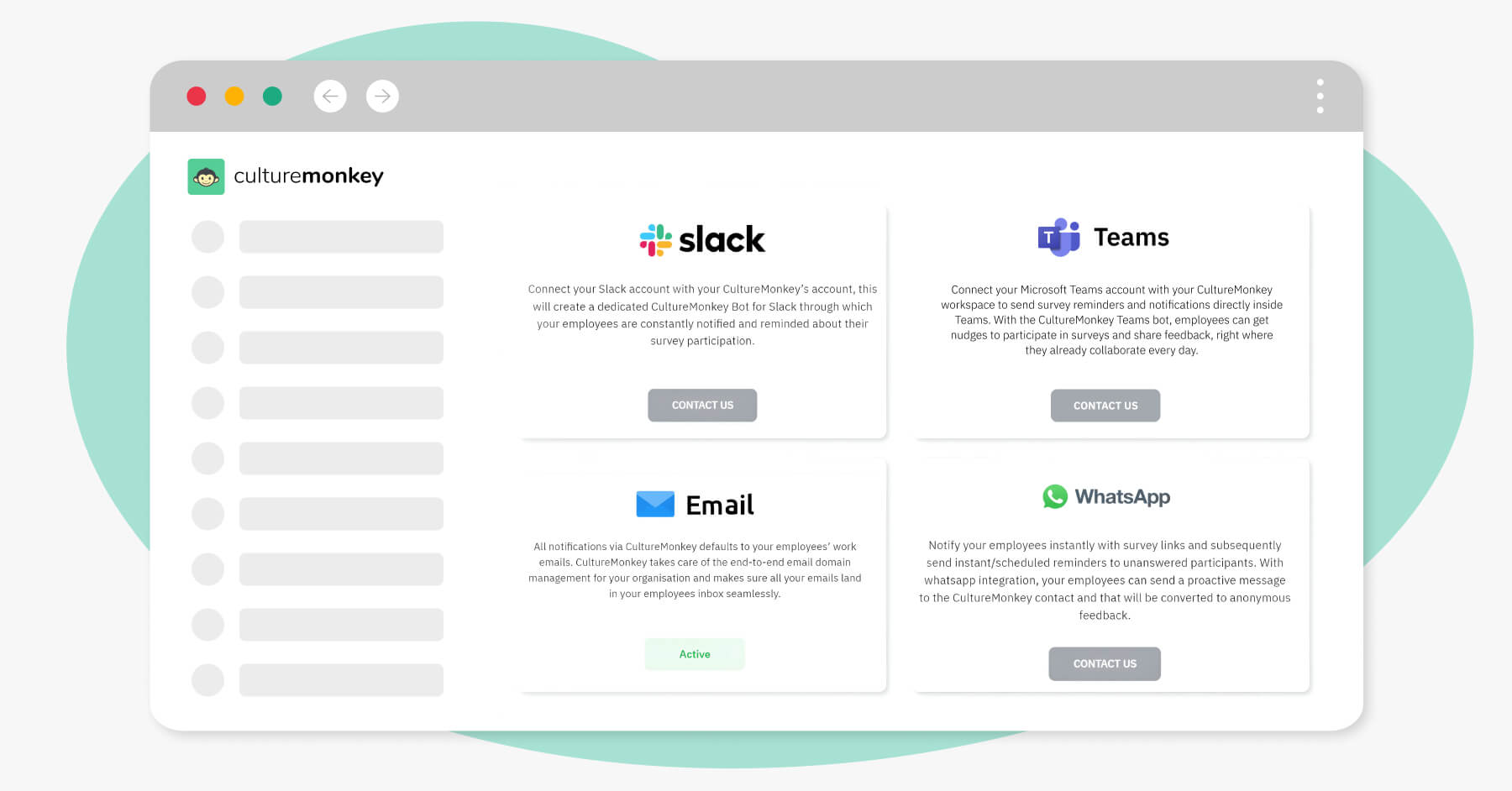
- Accurate results for high ROI: Analyze precise results to identify low-performing drivers. Use eNPS to address leadership gaps and foster employee-manager trust.
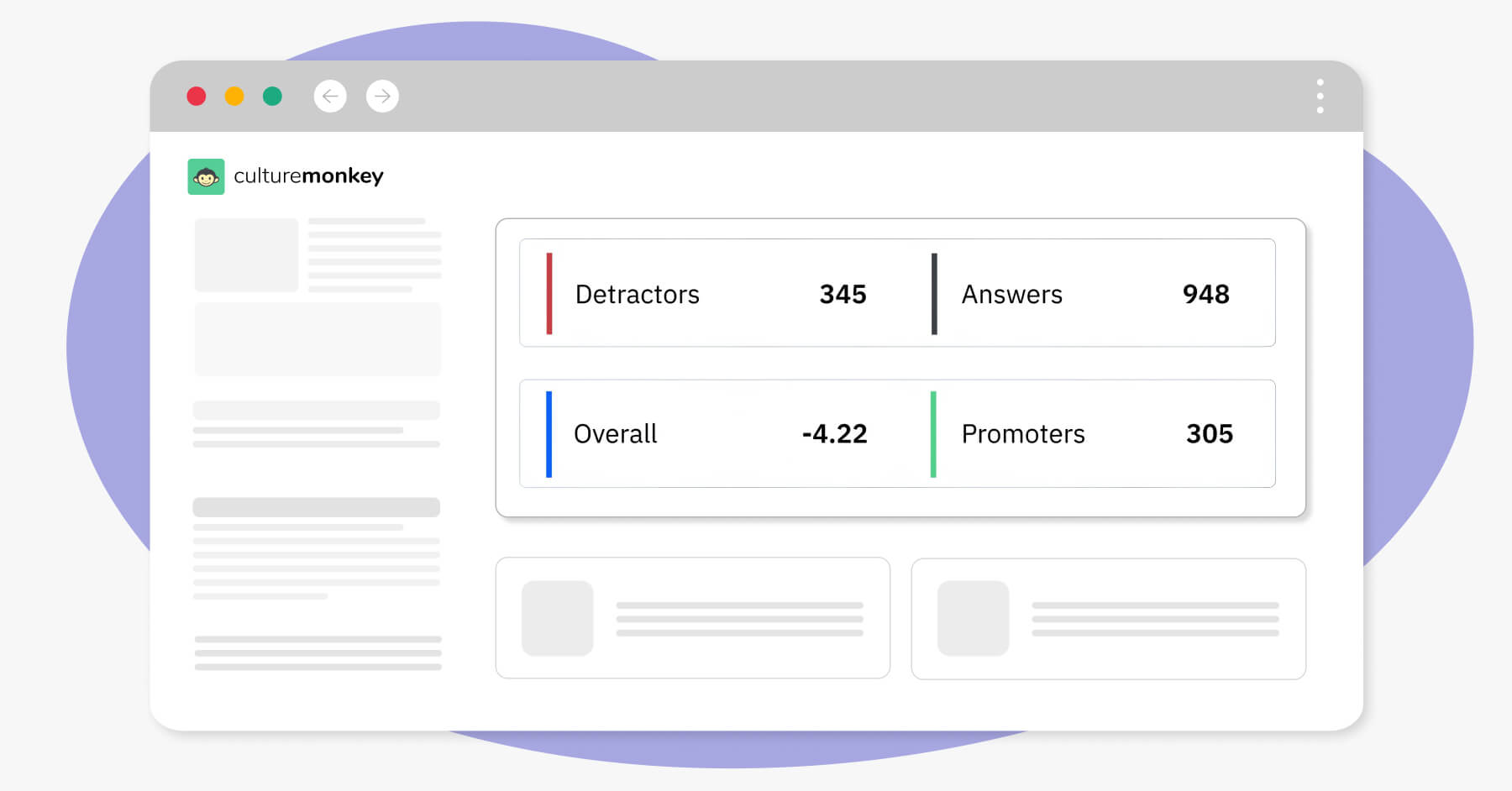
- Evaluate leadership impact: Dive deep into mNPS data to track manager effectiveness and identify trends in disengagement. Build stronger teams with tailored interventions.
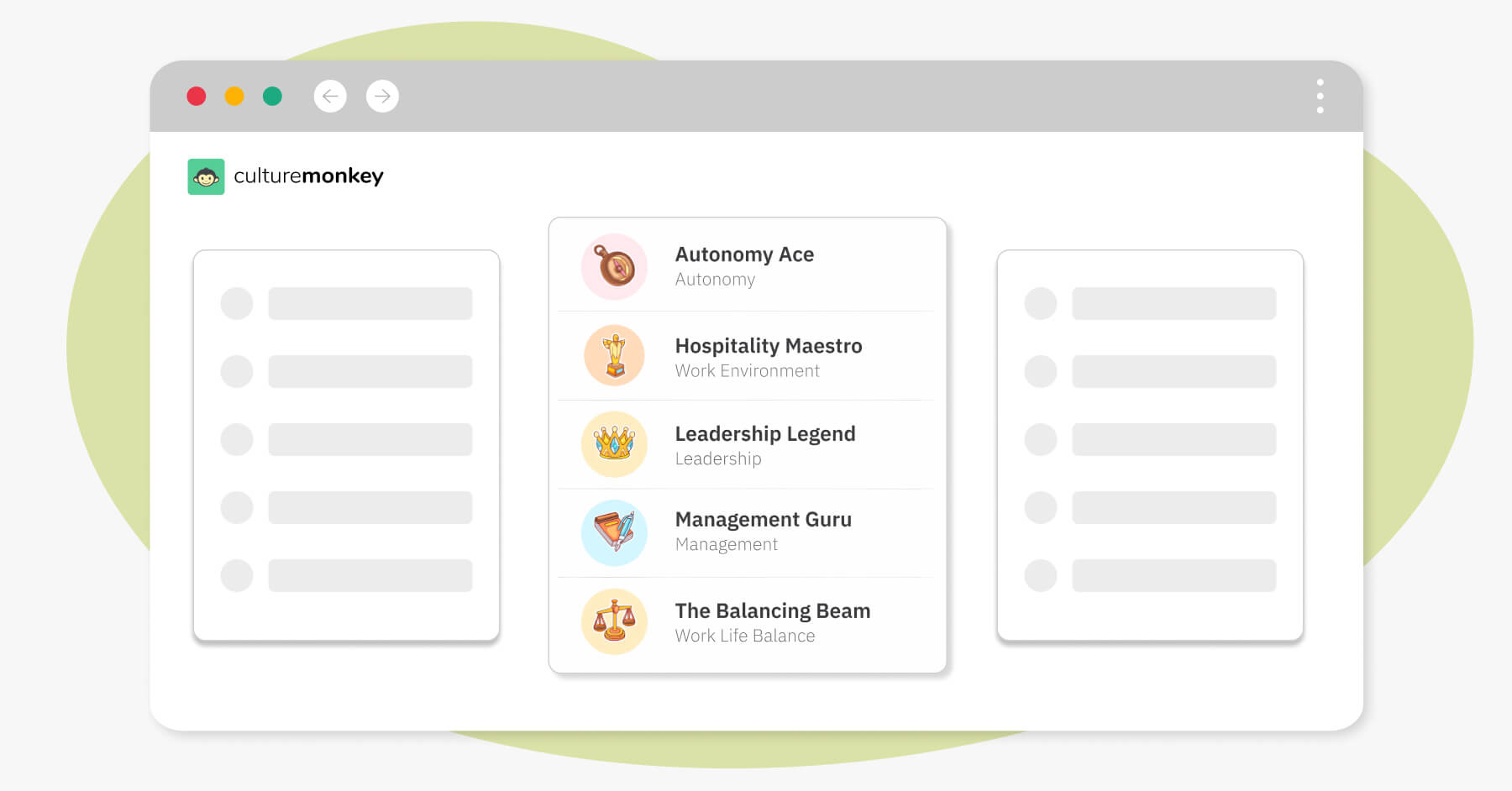
- Mitigate burnout: Identify stress and burnout trends through dashboards. Address red flags to improve retention and overall employee wellness.
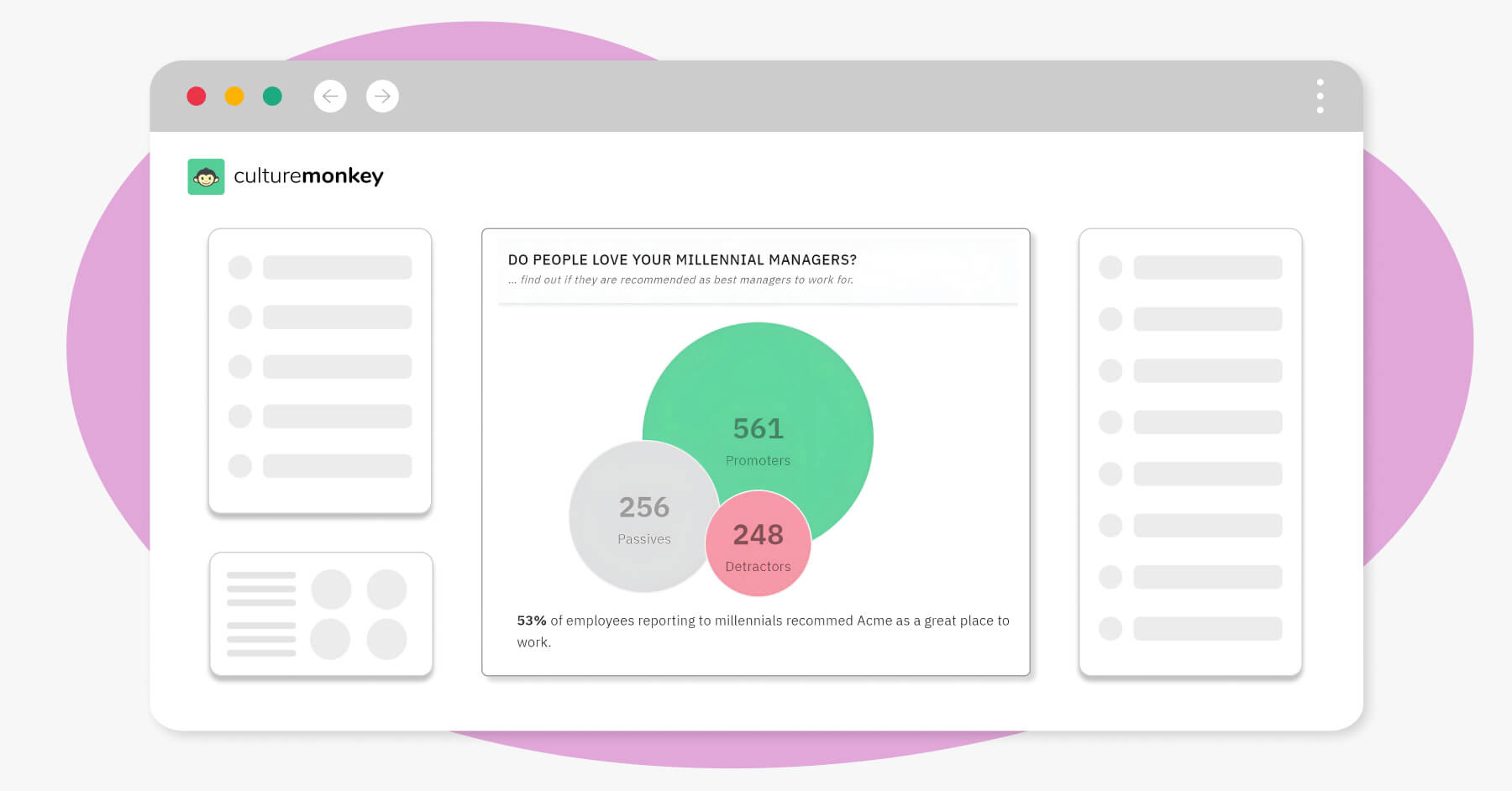
- Foster inclusiveness and recognition: Spot gaps in rewards and recognition to enhance inclusiveness. Evaluate promotion trends to boost job satisfaction and equity.
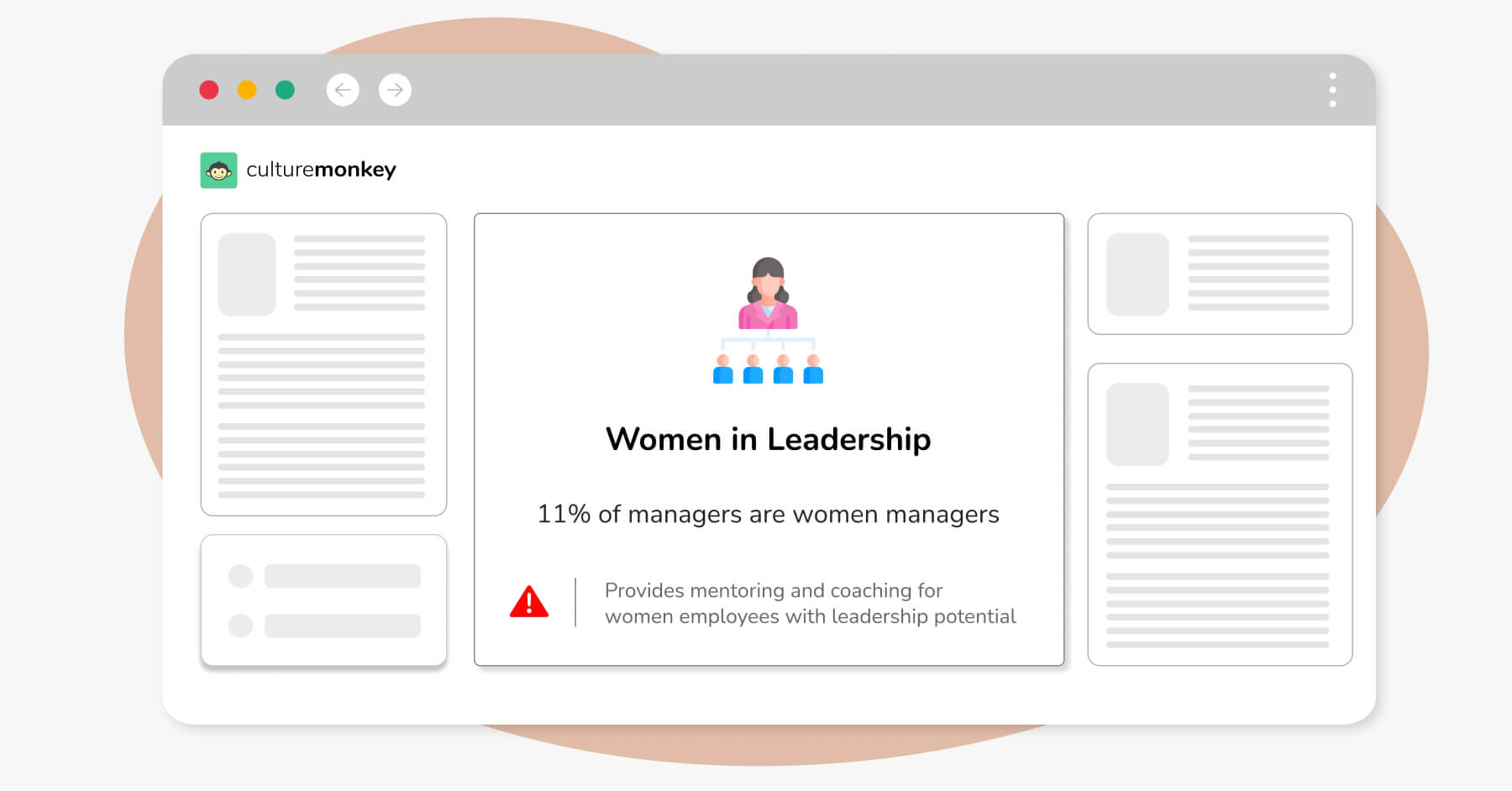
- Collaborative eNPS score improvement: Work with managers to resolve issues highlighted by detractors. Use AI-driven insights to empower leadership and create a thriving workplace.
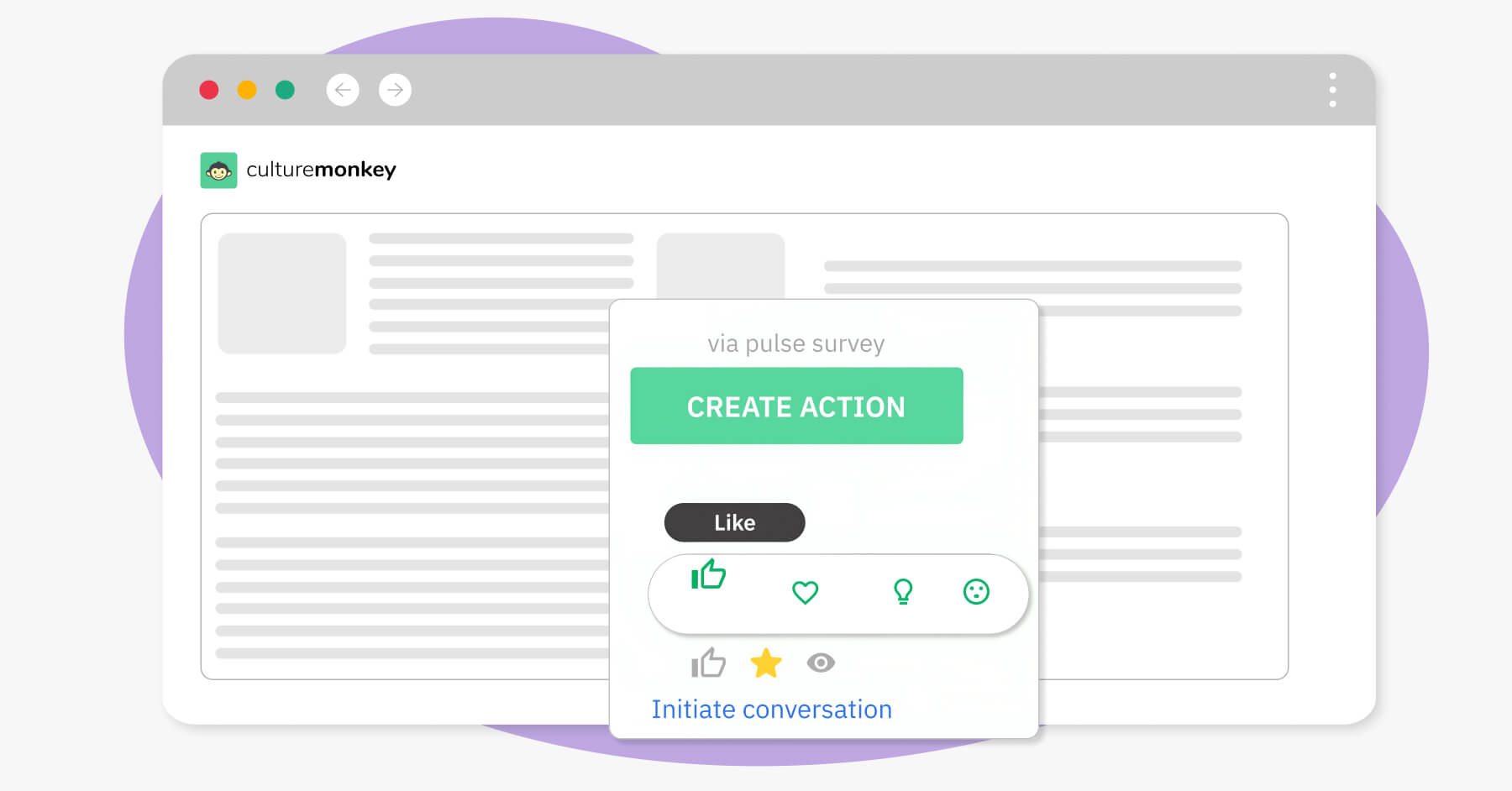
Conclusion
Workplace satisfaction should be of the utmost importance for employers to grow as an organization, both in size and revenue.
Satisfied employees are the ones who are loyal towards their organization and would stick with the organization even in the worst scenarios, as they don't work out of compulsion and won't have second thoughts about going the extra mile to help the organization grow.
CultureMonkey's anonymous employee survey and pulse survey tools will help you accurately measure your employee net promoter score, allowing your people leaders to improve employee satisfaction and workplace culture.
Don't wait to spot any challenges that your employees are facing in your organization or to make the change you always wanted to, don't wait. You can implement a user-friendly employee survey to dive deeper into actionable insights and develop competitive work culture.
Summary
eNPS surveys help organizations measure employee loyalty, satisfaction, and advocacy levels. These surveys categorize employees into promoters, passives, and detractors, providing insights into workplace sentiment.
By analyzing responses, businesses can identify strengths, address concerns, and foster engagement. Conducting regular eNPS surveys encourages open feedback, builds trust, and highlights a commitment to improvement. This proactive approach boosts morale, retention, and productivity while aligning the workplace with evolving employee expectations.
eNPS questions FAQs
1. What are 3 questions in NPS?
The 3 primary questions in NPS are:
- Simple and standard to the point question—Based on your experience with us, would you recommend our company?
- The reason “why” question—Why did you give us this rating?
- The default follow-up question—What one thing could we do differently to make a change?
2. What are typical questions in a NPS survey?
- On a scale of 1 to 10, how likely are you to recommend our company to your friends and family?
- On a scale of 1 to 10, how likely are you to stay with us for the next 12 months?
- On a scale of 1 to 10, how satisfied are you with your manager’s leadership and communication skills?
3. What is difference between NPS and eNPS?
The Net Promoter Score (NPS) measures customer loyalty, while the Employee Net Promoter Score (eNPS) measures employee loyalty. CultureMonkey is an employee engagement survey tool that helps companies collect and analyze eNPS data and other employee feedback to identify areas for improvement and take action to improve workplace culture and employee satisfaction.
4. When should you ask NPS questions?
Companies should ask NPS questions on a regular basis, such as quarterly or annually, to track changes in employee loyalty and identify areas for improvement. CultureMonkey helps companies automate the employee net promoter score process and provides real-time data analytics and reporting to help companies take immediate action to improve employee engagement and satisfaction.
5. What is an example of a follow up question on NPS?
An example of a follow-up question for NPS is "What is the primary reason for your score?" CultureMonkey helps companies automatically send follow-up employee engagement surveys based on their responses to eNPS questions and provides advanced analytics and reporting features to help companies identify trends, compare results over time, and take action to improve employee satisfaction and retention.
6. What is a good employee net promoter score?
A good Employee Net Promoter Score (eNPS) typically falls between 10 and 30, indicating a healthy level of employee satisfaction and advocacy. Scores above 30 are excellent, showing strong employee loyalty and positive workplace sentiment. However, acceptable scores can vary by industry and company context, so it's essential to benchmark against similar organizations for a more accurate assessment.
7. How often should you measure eNPS?
Organizations should measure eNPS quarterly or biannually to effectively track employee sentiment and respond promptly to changes. Frequent measurement allows for timely identification of trends and issues, enabling quick action to address concerns and improve the workplace environment. However, avoid over-surveying to prevent survey fatigue and ensure meaningful engagement from employees.
8. How is the eNPS score calculated?
The eNPS score is calculated by subtracting the percentage of detractors (employees who rate 0-6) from the percentage of promoters (employees who rate 9-10) on a 0-10 scale. The formula is: eNPS = % Promoters - % Detractors. The resulting score ranges from -100 to +100, providing a clear indicator of overall employee sentiment towards the organization.
9. When should organizations conduct eNPS surveys?
Organizations should conduct eNPS surveys during key business cycles, such as post-performance reviews, after significant organizational changes, or during annual engagement assessments. Timing surveys to capture employee sentiment after these events provides valuable insights into how such factors impact employee satisfaction and advocacy, helping to identify areas for improvement.
10. How can organizations use eNPS results to drive improvement?
Organizations can use eNPS results to identify strengths and weaknesses in employee engagement and satisfaction. By analyzing feedback, they can implement targeted initiatives to address concerns, enhance positive aspects, and improve overall workplace culture. Regularly communicating actions taken in response to eNPS feedback also builds trust and demonstrates commitment to employee well-being and development.




